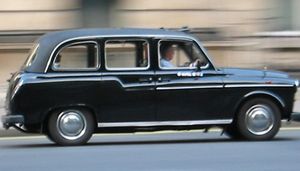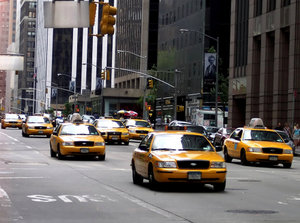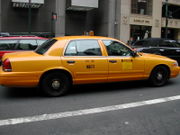Taxicab
Car Show
Taxicab
 A London black cab (Hackney
carriage.)
A London black cab (Hackney
carriage.)A taxicab (sometimes called taxi,
cab, or hack)
is a
vehicle for hire which conveys passengers between locations of their choice. (In
most other modes of public transport, the pick-up and drop-off locations are determined by the
service provider, not by the passenger, and are usually less expensive than
hiring a taxicab.) Although types of vehicles and methods of regulation, hiring,
dispatching, and negotiating payment differ significantly from country to
country, some common characteristics exist.
History and etymology
Horse-drawn for-hire
hackney carriage services began operating in both Paris and London in the early
17th century. Royal proclamations in both cities regulated the number of
carriages--the first example of taxicab regulation. In the 19th century, Hansom
cabs
largely replaced the older designs because of their improved speed and safety.
Although battery-powered vehicles enjoyed a brief success in Paris, London,
and
New York in the 1890s, the 1891 invention by German Wilhelm Bruhn of the
taximeter (the familiar mechanical and now often electronic device that
calculates the fare in most taxis) ushered in the modern taxi. (The "taxi" in
"taximeter" is related to the word "tax," or "rate.") The first modern
meter-equipped taxi was the Daimler Victoria, built by Gottlieb Daimler in 1897;
the first motorized taxi company began operating in Stuttgart
the same year.
Petrol powered taxis began operating in Paris in 1899, in London in 1903, and
in New York in 1907. The New York taxis were imported from France by
businessperson Harry N. Allen, who adapted the French word taxi-mètre and coined the word "taxicab" to describe the
vehicles he was importing. In time, the shortened term "taxi" came into common
usage. (Allen was also the first person to paint his taxis yellow, after
learning that yellow is the colour most easily seen from a distance.)
 The yellow taxicabs of
New
York City.
The yellow taxicabs of
New
York City.
Taxis proliferated around the world in the early
20th century. The first major innovation after the invention of the taximeter
occurred in the late 1940s, when two-way radios first appeared in taxicabs.
Radios enabled taxis and dispatch offices to communicate and serve customers
more efficiently than previous methods, such as using callboxes. The next major
innovation occurred in the 1980s, when computer assisted dispatching was first introduced.
There has generally been a legal struggle concerning the certification of
motor vehicles to be taxis, which take much more wear than a private car does.
In Britain, they were additionally required to meet stringent specifications,
for example, as concerns turn radius, which resulted for a time in having only
one make legally usable. In the US, in the 1930s the cabs were often
DeSotos or Packards. General Motors offered a specialized vehicle for a time,
named the General. The firm Checker came into existence then, and went out of business in the 1970s. Its cars were
specially built to carry "double dates." But now New York City requires that all
taxicabs be ordinary cars. They are usually large Fords. In the 1960s in Europe,
Mercedes Benz and Peugeot offered diesel taxicabs. This form of engine is now
quite common there.
(Sources:
BBC America: Ask a Cabby;
The New York City Taxicab Fact Book (2003), p. 22;
Today in Science History).
Vehicles
 A traditional
New York City taxi, the Crown Victoria
A traditional
New York City taxi, the Crown Victoria
Taxi service is typically provided by
automobiles, but various human powered vehicles (such as the rickshaw) and
animal powered vehicles (such as the Hansom cab) or even boats (such as water
taxis or gondolas) are also used or have been used historically. In Western
Europe it is not uncommon for expensive cars such as Mercedes-Benz to be the taxi of choice. Often this decision is based upon
the perceived reliability of, and warranty offered with these vehicles. These
taxi-service vehicles are often equipped with four-cylinder turbo-diesel engines
and low levels of equipment, and are not considered luxury cars. (This often
surprises Americans, who are used to seeing only the upmarket trims and
associate Mercedes-Benz cars with luxury.)
Taxis in less developed places can be a completely different experience, such
as the ancient French cars typically found in
Cairo, however starting March, 2006 new yellow
modern taxi entered the service operated by various private companies. Taxis
differ in other ways as well: London's black cabs have a large compartment
beside the driver for storing bags, while many fleets of regular taxis also
include wheelchair accessible taxis among their numbers (see below). Although
taxis have traditionally been
sedans,
minivan and
even SUV taxis are
becoming increasingly common. In many cities,
limousines
operate as well, usually in competition with taxis and at higher fares.
See also
External links
Home | Up | Hooptie | Luxury vehicles | Coupe | Sedan | Sport utility vehicle | Station wagon | Hatchback | Semi-trailer | Taxicab
Car Show, made by MultiMedia | Free content and software
This guide is licensed under the GNU
Free Documentation License. It uses material from the Wikipedia.
|







